Picture gallery
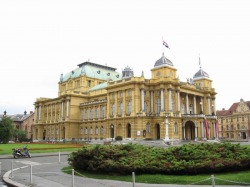
The Croatian National Theatre (Croatian: Hrvatsko narodno kazaliste - HNK) is located in Zagreb. The blueprints for the building were ordered from the famous Viennese architects Ferdinand Fellner and Herman Helmer, authors of forty more European theatre buildings. After only 16 and half months of construction works, the theatre building was finished according to plans and it was ceremoniously opened by the emperor Franz Joseph I, who finally symbolically beat on the balcony above the main entrance with a silver hammer, made by the sculptor Robert Frangeš Mihanović on October 14, 1895. The neo-baroque building of the Croatian National Theatre in Zagreb is surrounded by numerous buildings that have a great monumental value and which represent the Croatian architecture of the end of the 19th and the beginning of the 20th c.
Churches
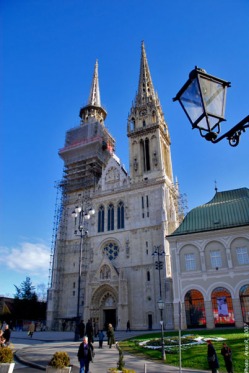
Zagreb Cathedral on Kaptol is probably the most famous building in Zagreb, as its spires can be seen from many locations in the city. At the end of the 15th century, the Turks invaded Bosnia and Croatia, triggering the construction of a renaissance fortification wall around the cathedral. Few of these fortifications are still intact. In the 17th century, a fortified renaissance watchtower was erected on the south side, and was used as a military observation point, because of the Turkish threat.
In 1880, the cathedral was severely damaged in an earthquake. The main nave collapsed and the tower was damaged beyond repair. The restoration of the cathedral in the neogothic style was made by Hermann Bollé, bringing the cathedral to its present form. As part of that restoration, two spires of 105 m height were raised on the western side, both of which are in the process of being restored during a massive general restoration of the cathedral.
Landmarks
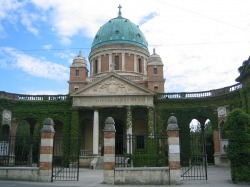
The Mirogoj Cemetery is considered to be one of the most beautiful cemetery parks in Europe and, thanks to its design, numbers among the more noteworthy landmarks in the City of Zagreb.
The cemetery was begun in 1876 on a plot of land owned by the linguist Ljudevit Gaj.
Architect Hermann Bollé designed the main building. The construction of the arcades, the cupolas, and the church in the entryway was begun in 1879. Work was finished in 1929.
In the arcades are the last resting places of many famous Croatians.
The cemetery inters members of all religious groups: Catholic, Orthodox, Muslim, Jewish, Protestant and irreligious graves can all be found.
Museums
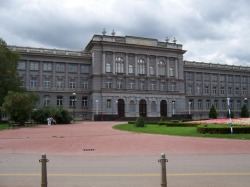
Mimara is an art museum in the city of Zagreb, Croatia. It is situated at the Roosevelt Square, housing the donation by Wiltrud and Ante Topić Mimara.
Of the total of 3,700 varied works of art, more than 1,500 exhibits constitute permanent holdings, dating from the prehistoric period up to the 20th century. Some of the most famous exhibits include works by Lorenzetti, Raffaello, Giorgione, Veronese, Caravaggio, Canaletto, 60 paintings by the Dutch masters Rembrandt, Van Goyen, Ruisdael, 50 works by the Flemish masters Van der Weyden, Bosch, Rubens, Van Dyck, more than 30 by the Spanish masters Velasquez, Murillo, Goya, some 20 paintings by the German masters Holbein, Liebermann, Leibl, some 30 paintings by the English painters Gainsborough, Turner, Bonington and more than 120 paintings by the French masters Georges de la Tour, Boucher, Chardin, Delacroix, Corot, Manet, Renoir, Degas.
The museum was opened in 1987. The building itself originates from the 19th century, overseen by a Zagreb architect Kuno Waidmann, and it served as a gymnasium.
Churches
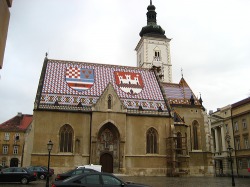
St. Mark's Church (Croatian: Crkva sv. Marka) is the parish church of old Zagreb.
The Romanesque window found in its south facade is the best evidence that the church must have been built as early as the 13th century as is also the semicircular groundplan of St. Mary's chapel (later altered).
In the second half of the 14th century the church was radically reconstructed. It was then turned into a late Gothic church of the three-nave type. Massive round columns support heavy ribbed vaults cut in stone and an air of peace and sublimity characterizes the church interior in its simplicity. The most valuable part of St. Mark's Church is its south portal, considered to be the work of sculptors of the Parler family from Prague (end of the 14th century).
The Gothic composition of the portal consists of fifteen effigies placed in eleven shallow niches. On top are the statues of Joseph and Mary with the infant Jesus, and below them one can see St. Mark and the Lion; the Twelve Apostles are placed on both sides of the portal (four wooden statues replaced the original ones which had been destroyed). In its artistic composition and the number of statues, this portal is the richest and the most valuable Gothic portal in South Eastern Europe.
Outside, on the northwest wall of the church lies the oldest coat of arms of Zagreb with the year 1499 engraved in it (the original is kept in the Zagreb City Museum).
On the roof tiles are laid so that they represent the coat of arms of Zagreb (white castle on red background) and Triune Kingdom of Croatia, Slavonia and Dalmatia.
Statues
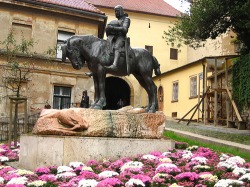
Statue of Saint George, standing over the dead dragon (in white). Zagreb, Croatia.
Behind is the Stone Gate (Kamenita Vrata), built in the 13th century and eastern entrance to Gradec, one of the two original hill settlements forming the old upper town Gornji Grad (the other being Kaptol). Gradec was the center of administration and economy compared to the religious Kaptol. During the Middle Ages, it was walled and could be accessed by five gates, the Stone Gate being the only one remaining.
In 1731, a fire destroyed the wooden buildings and parts of the gate, leaving intact only a painting of the Virgin Mary The painting is believed to be sacred and is now the object of a small shrine in the interior of the gate.
